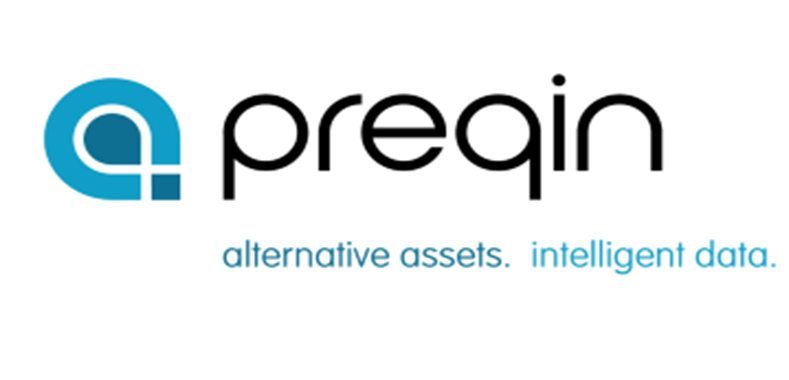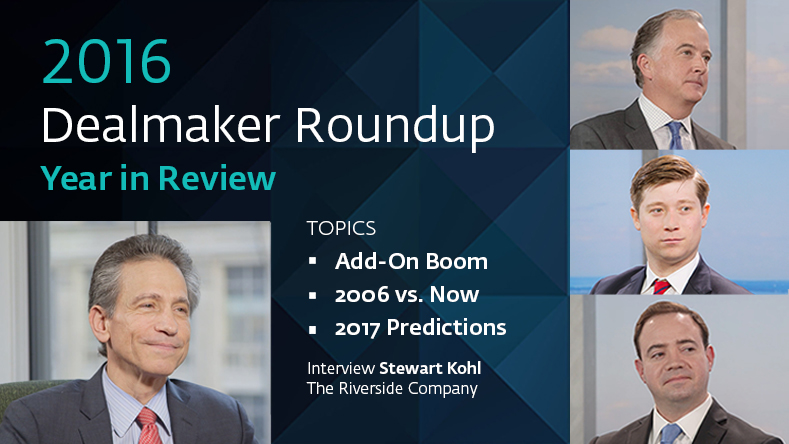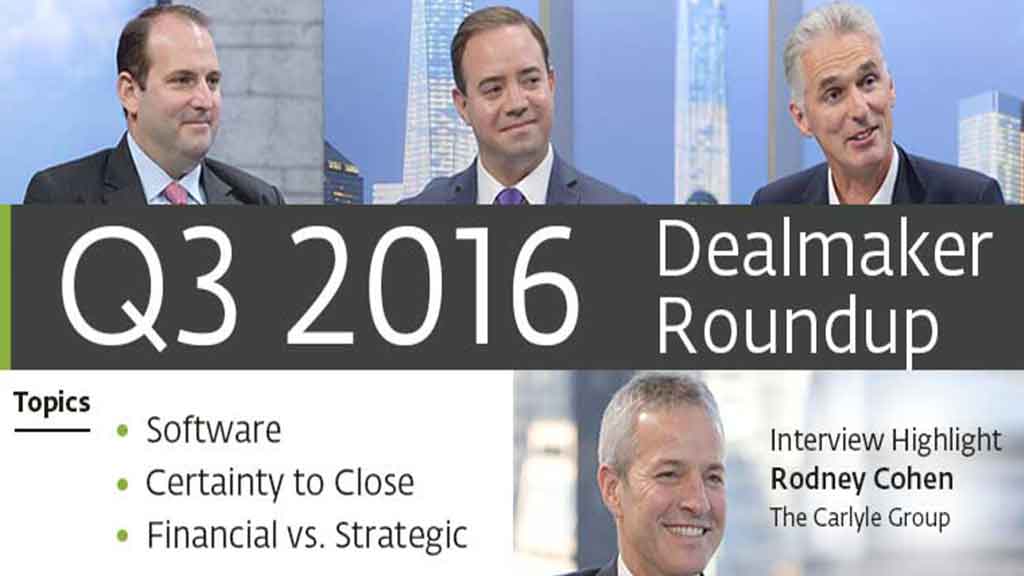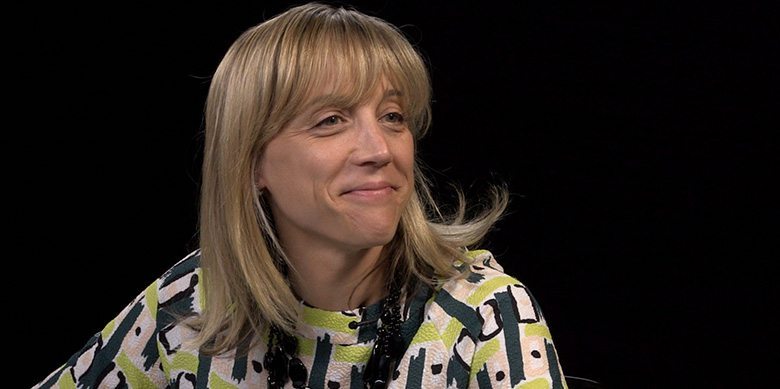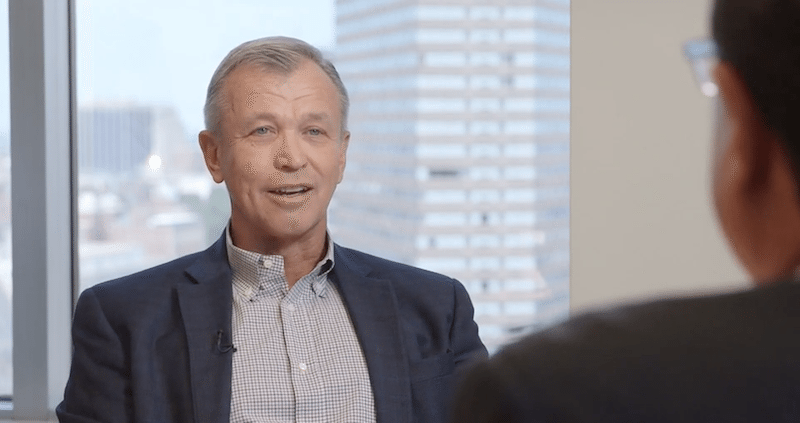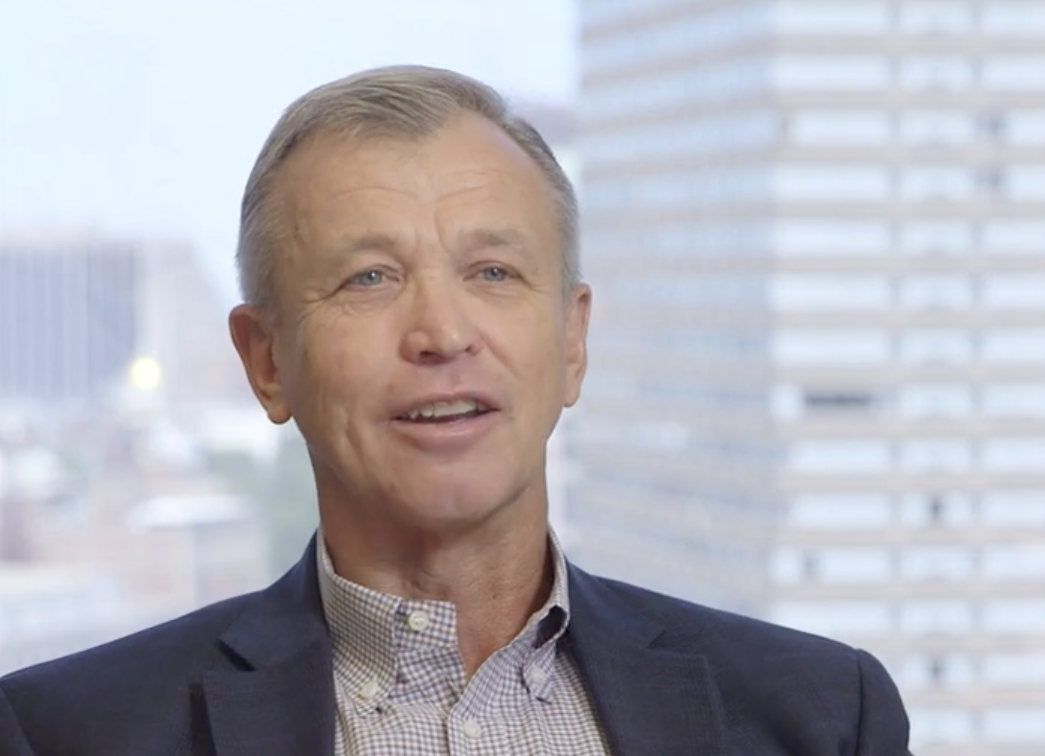Watch Privcap & Preqin’s Dealmaker Roundup, Q2 2016
Privcap’s new quarterly video series featuring expert insights on the private equity dealmaking environment. In this episode, Ryan Budlong of Harris Williams & Co., Chris Elvin of Preqin, Harshad Khurjekar of RSM, and Privcap CEO David Snow discuss the Q2 deal tally, whether the surge in deals will continue, hot sectors for transactions, and exit activity. Plus, a special guest interview with Geoff Rehnert from Audax Group.
Transcript Download Transcript
Preqin Privcap Dealmaker Roundup, Q2 2016
David Snow, Privcap: In today’s episode, will the deal serge continue; hot sectors to watch; private equity exits look set to grow. And an interview highlight with Geoff Renhert of Audax Group. Hello and welcome to Privcap’s Dealmaker Roundup. I am David Snow, CEO of Privcap. And today we’re joined by Ryan Budlong of Harris Williams, Chris Elvin: of Preqin and Harshad Khurjekar of RSM. Gentlemen, welcome to Privcap. Thanks for being here.
Ryan Budlong, Harris Williams: Thank you.
Snow: So we’re talking about the private equity deal market and what’s been going on in that market in Q2 2016 and, very importantly, what we think will happen for the rest of the year.
Our first topic is all about the fact that there has been a deal volume surge, at least compared to the first quarter. So I’d like to understand will the deal surge continue. Maybe starting with a question for you, Ryan, why was it that things were a bit sleepier as far as deal volume was concerned in the first quarter?
Budlong: Well, I think that the middle market in the first quarter continued to be pretty active. What we saw was a reduced number of mega deals kind of year of year, from ‘15 to ‘16. So it made things seem a little bit slower.
And then, additionally, the credit markets were a little bit choppier in the first quarter of 2016. So some deals that needed to access the capital markets to get that debt financing probably tapped the brakes a little bit and waited for the second quarter to get kicked off.
Chris Elvin:, Preqin: So, if we look at Q2 as a whole, whilst the actual deal value was down, there was actually more than 1,000 deals completed in Q2. That was largely attributed to the US and Europe where about 89% of those deals were done in those locations. Certainly it sort of infers the number of smaller deals and the mid-sized deals there still running robustly.
Snow: And, Harshad, as you look among your clients and in the market that you service, what do you see as the main drivers of deal activity right now and do you think that those drivers will continue?
Harshad Khurjekar, RSM US LLP: So I’m seeing significant activity in the add‑ons, especially compared to the last year. People have paid higher market prices on the platform and the only way you’re going to justify those higher market prices by doing add-on acquisitions at lower market, but also blended cost of acquisitions is coming down.
Snow: he US middle market is its own very large space that maybe doesn’t make the national headlines, but is very robust and perhaps a better indicator of really what’s going on in the economy. Do you see sort of a difference in what’s going on in the middle market versus the large deal market?
Budlong: We see the middle market be traditionally a lot more stable environment in which M&A volume comes from. And I think part of that is it’s not as susceptible to stock market fluctuations, overall, you know, a kind of public market investor market sentiment and so it tends to be a little bit more stable than the mega deals.
Snow: Describe your level of business right now, Harshad, as far as your business.
Khurjekar: We are extremely busy. I’m sold out for the next six weeks at least and looking at probably eight to 10 weeks of, you know, solid project pipeline. As, you know, Ryan mentioned, there is significant activity in the middle market.
Snow: Chris, your company, Preqin, tracks the nature of private equity deals and there is a huge percentage of them are sponsor-to-sponsor deals, sometimes called secondary deals in which a private equity firm sells to another private equity firm. Talk about that phenomenon and do you think it’s here to stay and what does it mean for the market?
Elvin: Historically, the secondary transactions like that have actually been viewed by some in a negative light. But I think, if you look at the actual overall asset class, there are more assets held by private equity firms than have ever been historically. And I think, if you look at the skill set and size and resources of the different private equity firms, there is a sort of natural logic to a smaller entity upselling to a bigger private equity firm that asset.
Budlong: So what one private equity firm may have brought to a portfolio company, another private equity firm can bring something totally different to them as well.
The other thing that we’ve seen over the years at Harris Williams is the valuation differences between strategic buyers and financial buyers have significantly narrowed. It used to be where strategic buyers would pay significant, significant premiums for assets. We’ve seen that valuation cap narrow quite substantially over time.
Snow: And do you think this is because private equity firms aren’t going after the same kinds of returns.
Budlong: I think, as a whole, private equity is underwriting lower expected returns, going forward, just given how competitive the market is right now and the low interest rate environment we’re in.
Khurjekar: I’m seeing a lot of activity where there is more involvement from operating partners, specialist groups by private [goodie] buyers where, you know, they are predominantly getting into family-owned businesses, which are not well run and they can be fixed with the right expertise and that’s where probably the secondary play comes into play where, you know, niche focused, you know, private equity funds are buying companies, fixing it, improving it and those are back to the larger private equity funds, which wasn’t the case say 10 years back.
Snow: I guess final topic and that is Brexit. Chris, your firm follows private equity deal activity around the world. What do you think is going to happen by way of European and specifically UK deal activity? Is there evidence that there has been a slowdown?
Elvin: We’ve already conducted some surveys of fund managers within the industry to find out their views on whether they’ll be looking to sort of invest more or reduce the number of investments. And it’s a mixed bag.
About over a third of the fund managers we surveyed said in the next 12 months, they’re going to be looking to invest less in the UK as a result. Only time will tell what the sort of long-term effect of that is. But as a result, that sort of uncertainty question could be quite a poisoned chalice for deal activity with many proceeding sort of cautiously over the sort of near, short to longer term.
Snow: Okay, let’s move on to our next topic, which is hot sectors to watch. Each of you are interested in a certain subsector of the private equity deal market. And I’m going to ask you about them and why you find them to be so interesting. So maybe starting with Ryan.
Budlong: I think what we’ve seen is a noticeable improvement in deal activity in the food and beverage world. Again, as investors start to look forward a little bit and anticipate a cyclical downturn at some point, food and beverage has traditionally been a safe place for investors to put their money. Obviously people are going to continue to need to eat and drink. It’s a very stable non‑cyclical market. In addition to that, there’s a number of subsectors within food and beverage that have some secular growth trends, like health and wellness that will continue to be tail ends to that market for a number of years going forward.
Snow: Okay, let’s move over to you, Chris. You’ve seen some interesting activity in the healthcare space among private equity firms. What have you seen and what do you think is driving it?
Elvin: What we’ve seen more recently, particularly in the sort of last four quarters is a pickup in healthcare deals.
And I think that’s directly correlated to some number of funds being raised and the amount of capital being raised in the buyout space, specifically targeted at healthcare. And, you know, whilst the majority of healthcare activity seems to still take place in developed economies as the sort of healthcare in emerging markets becomes more established, that’s also presenting opportunity as well.
Snow: Harshad, you’ve seen some interesting activity in the business services sector. What are you seeing and what do you think is driving that?
Khurjekar: People are interested in business services because of low CapEx requirements for the business. So it’s more asset-lite businesses, you know, opportunity for significant cash flows. There is an [EC] play going on throughout the business services, you know, tech-enabled logistics, tech-enabled media, tech-enabled everything pretty much. And those companies are getting, you know, pretty high multiples because of, you know, unlimited opportunities that companies may present.
Snow: So onto our next topic, private equity exit activity is regaining its stride. Since 2013, the number of private equity backed exits has mostly been above, you know, roughly 400 per quarter, according to Preqin data. But in a couple of recent quarters, the number and the volume has been down. Chris, you know, what is your read on the coming exit activity?
Elvin: What happens in the remainder of 2016, I think caution will be the sort of outcome that’s most likely. And my personal viewpoint would be that the exit activity will remain robust, but is probably likely to be below the levels we saw in 2015.
Dave: Ryan, what do you see by way of exit activity among the private equity firms that you know and if you could specifically comment on IPOs as an exit route, what do you think will happen in the second half of the year?
Budlong: The IPO side, I think it will probably continue to be a little bit slow. The first part of the year got off to a very slow start for public exits.
Historically, companies went public for greater access to the capital markets. I think there’s a much more robust private market, capital market today. So they don’t need some of those same resources that historically you only got from being a public company.
And then, finally, managers often times have a preference to operate in a private manner so that they can make what they feel are better longer-term decisions and not have to report on a quarterly basis.
Khurjekar: I’m quite optimistic about the exit activity over the next 12 months. But I don’t think it’s going to be, you know, extraordinary. It’s going to be solid because of the following reasons. You know, the multiples are still high. There is a lot of dry powder. For good companies, there is a lot of private capital available so people are ready to pay a higher multiple for good companies.
Snow: Should we assume that there will be less cross-border exit activity as a result of it?
Khurjekar: Yeah, I would. That’s exactly what everybody’s expecting and they’re sitting on the sidelines, honestly, until the dust settles down.
Budlong: The one thing we have seen is Canadian private equity firms that own US assets. So firms that invested Canadian dollars into US assets that can now sell those assets and return US dollars back to the Canadian markets, there is a nice arbitrage on the currency exchange rate if they made those investments, you know, three to five years ago when the Canadian dollar was a lot higher.
Budlong: I mean I think all of the ingredients for a healthy M&A market are there. The pipeline that we are seeing is continuing to build. Is it going to be a record year? I don’t suspect that will happen, but I think it will be a very solid year with multiples remaining, you know, at very high levels.
Khurjekar: And, you know, 2015 was a very solid year. So, you know, if it’s at par, we have a really good M&A market.
David Snow: Okay, now let’s turn to a highlight from a recent interview we did with Geoff Renhert, a co-founder of Audax Group.
Don Lipari, RSM US LLP: With so much capital committed to private equity, it’s more and more complicated to differentiate yourself in the marketplace.
Geoff Renhert, Audax Group: Absolutely.
Don: And when there’s too many dogs chasing too few cats, valuations have a tendency to stay high.
Geoff: Now, I will say, I’ve been in the business now 32 years. And every year, starting in 1985, actually, late ’84, I have heard the common wisdom being that there’s too much money chasing too few deals. So every year that’s what people have said, relative to the prior year. So it’s economics 101, you know. If demand is high, supply keeps increasing to meet that demand. And the supply of capital has increased every single year; the total amount of capital under management has increased every single year I’ve been in the business.
Public markets are, depending on the year, they’re up and they’re down, but they’re generating, on average, 500 basis lower return than the median private equity returns. So there’s still a premium to what you can get in public markets.
Snow: Okay, that’s it for this episode of Dealmaker Roundup. Thank you to our experts for being here and, of course, thanks to our audience for watching and we will see you next time.




